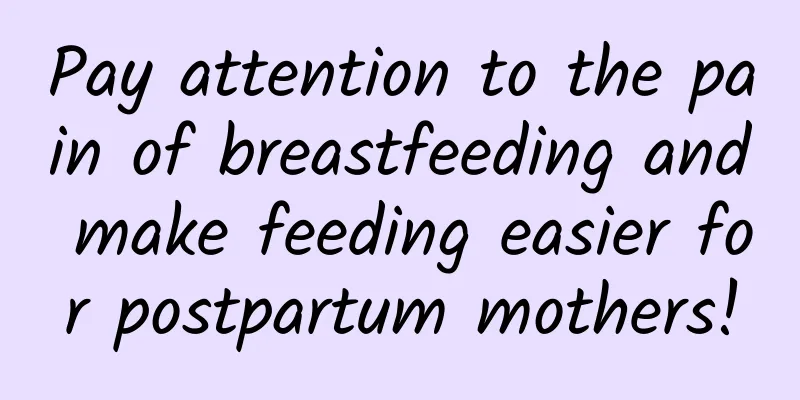Pay attention to the pain of breastfeeding and make feeding easier for postpartum mothers!

|
For a long time, "whether to breastfeed after childbirth" has been a headache for postpartum mothers. Although mothers know that natural breast milk can not only provide sufficient nutrition for babies and lay a solid foundation for their immune health, but also promote mothers' postpartum recovery and reduce the risk of breast cancer and ovarian cancer, whenever they want to exclusively breastfeed, problems such as insufficient milk and breast pain form layers of obstacles. Therefore, even though breastfeeding has been advocated for many years, according to a 2018 data survey, the actual breastfeeding rate in China is only 28%, and it has not increased in the past three years. The World Health Organization (WHO), the American Academy of Pediatrics, and the Chinese Medical Association have long recommended that babies should be exclusively breastfed from 0 to 6 months of age, but these feeding pains left to mothers also need to be solved in a timely manner to help mothers successfully carry out breastfeeding. In this issue of popular science, the editor will introduce these feeding pains to you and give solutions, hoping to be helpful to mothers. The first pain - the pain of "starting breastfeeding" Breastfeeding usually refers to the first feeding after a newborn is born. The first breastfeeding can start in the delivery room. WHO recommends that babies should be breastfed within half an hour after birth. Mothers who have a caesarean section should also try to breastfeed within 24 hours. After the baby is born, it should be placed on the mother's chest as soon as possible, with direct skin contact. The baby sucking the nipple is conducive to the secretion of prolactin and helps the milk flow out smoothly. How to open milk
Mothers should try to relax as much as possible. Mental stress will affect milk secretion. Some new mothers have the misunderstanding that "milk is produced only when the breasts are swollen". In fact, milk has been stored in the breasts since the 7th month of pregnancy. We only need to observe the baby's performance and feed according to his needs. Adjust the breastfeeding position and posture, the mother and baby have more skin contact, the baby holds the nipple and areola, and sucks more, and the breast milk will naturally become rich.
New mothers should maintain the good habit of drinking milk every day during pregnancy and eat more fresh vegetables and fruits. The high fat in traditional pig's trotters, chicken soup, and crucian carp soup will not only block the mammary ducts and hinder breast milk secretion, but excessive supplementation will also cause fat accumulation. Clinical studies have also shown that excessive supplementation of liquid in mothers' confinement meals cannot effectively increase breast milk secretion. 3. Massage stimulation Before each breastfeeding, apply hot compresses to both breasts for 3-5 minutes to promote blood and lymphatic circulation. You can also combine breast massage: place your hands on the upper and lower parts of the breasts and massage the entire breast in a circular direction, or open your hands and place them on both sides of the breasts, squeeze from the breasts to the nipples to stimulate the milk ejection reflex, squeeze out the milk, and soften it for easier sucking. Appropriate massage stimulation can help mothers relieve tension, soften the nipples, and make breastfeeding easier. 4. Feed both breasts If you only feed one side at a time, the other breast will not be stimulated, and the natural milk secretion will be less. Try to let the baby suck on both breasts. Some babies have a small appetite and only need milk from one breast. In this case, you may want to use a breast pump to suck out the milk from the other side and store it in the refrigerator. The baby's sucking on the nipple is the best stimulation for breast milk secretion. Let the baby fully empty the breast every time you breastfeed, which is also conducive to the re-production of milk. 5. Get enough rest and keep a good mood Lack of sleep and bad mood are the "number one culprits" of reduced milk supply. Breastfeeding mothers should take time to rest, avoid overwork, and maintain a good mood. The second pain - the pain of nipple cracking Smooth milk production is only the first step. Long-term sucking, inverted or flat nipples, improper breastfeeding posture, and improper breastfeeding methods may all cause nipple cracking and pain. Mothers will be afraid of being sucked when breastfeeding, and babies may not be able to suck normally. The solutions are as follows:
Don't be frustrated or feel annoyed and self-blaming, but actively look for the cause, whether it is due to improper breastfeeding posture or the baby's own short tongue tie. Studies have shown that inverted or flat nipples have no significant effect on breastfeeding rates. It is normal for new mothers to have improper breastfeeding postures. They can be effectively improved under the guidance of a therapist and in a scientific manner. Remember not to give up breastfeeding because of this.
For mothers who are born with short and flat nipples, (1) Before breastfeeding: Gently pull and twist the nipples to help them stand up and facilitate latching. (2) During breastfeeding breaks: Use wet dressings (lanolin, egg yolk oil) to keep the wound moist and reduce pain. (3) After breastfeeding: Apply breast milk to the nipples to promote their recovery. When nipple cracks are severe, stop breastfeeding and use manual compression or a breast pump to drain the milk to prevent inflammation. The third pain - breast pain and mastitis Long-term insufficient sucking, milk not being emptied, and not paying attention to hygiene during breastfeeding can cause breast congestion and swelling, and in severe cases can even lead to mastitis. Common symptoms are breast pain, with or without breast redness, swelling, and lumps. The solutions are as follows:
As mentioned above, hot compresses, massages, and correct breastfeeding and sucking postures are all conducive to the complete discharge of milk. Timely cold compresses after breastfeeding can also help relieve swelling and pain. At the same time, attention should be paid to feeding the baby on demand. Effective and frequent breastfeeding or milking rather than regular and quantitative feeding can ensure adequate nutrition while avoiding breast swelling.
Mothers should seek specialist treatment from a breast surgeon in a timely manner, take symptomatic supportive measures such as emptying the breasts, resting, and analgesia, and use antibiotics when necessary; in severe cases, breastfeeding should be suspended, but the breasts should still be emptied. The pain of breastfeeding has become an obstacle for most mothers to persist. After learning the methods or measures recommended above, I hope it will be easier for mothers to persist. In addition, the company of family members and the encouragement and support of husbands are also important conditions for mothers to persist in breastfeeding. Successful breastfeeding is by no means the responsibility of the mother alone. Studies have shown that educating fathers about breastfeeding can effectively increase the breastfeeding rate. Therefore, fathers also need to do their homework and strengthen their company. Finally, I wish every mother a happy and smooth breastfeeding journey. |
>>: How to make folds on siomai? What is the essential difference between siomai and steamed buns?
Recommend
What to do if you are worried about miscarriage
Fetal arrest has occurred in many pregnant women,...
Should I take emergency contraceptive pills on an empty stomach or after a meal?
If a woman does not take protective measures when...
Why don't I have dysmenorrhea after giving birth?
There are many causes of dysmenorrhea, including ...
Postpartum body recovery
Women also need to pay attention to many issues a...
Is it normal not to vomit after two months of pregnancy?
We all know that women will experience pregnancy ...
Detailed explanation of the difference between long-term contraceptive pills and emergency contraceptive pills
There are many kinds of contraceptive measures an...
How to stop bleeding quickly if menstruation is too heavy
Many women always have too much menstrual flow. T...
Why do pregnant women feel cold?
For pregnant women, the abnormal conditions that ...
Why do some people's hands peel in autumn?
Some skin problems are not very serious, but they...
How long should I wear nursing bra after giving birth?
We all know that mothers can wear bras during the...
Does the child need to go to the hospital immediately if he has a fever?
Recently, the number of patients infected with my...
Why is it easy to gain weight during pregnancy?
Because many women are very concerned about their...
What are the disadvantages of having a baby too early?
There is a legal marriage age for women, but now ...
Brown on the sixth day after abortion
There are always some unexpected things happening...









